You can easily craft anxiety-busting herbal tea blends at home, transforming simple ingredients into soothing brews. Start with calming herbs like chamomile, lavender, and lemon balm for a peaceful mix. Combine equal parts of your chosen herbs, and steep them in hot water for 5-7 minutes. Sweeten your tea with honey for extra comfort. Make sure you use high-quality ingredients and store your blends in airtight containers to keep them fresh. This mindful process not only relaxes you but also enhances your tea experience. There's so much more to explore, so why not uncover additional tips and recipes for your tea journey?
Benefits of Herbal Teas
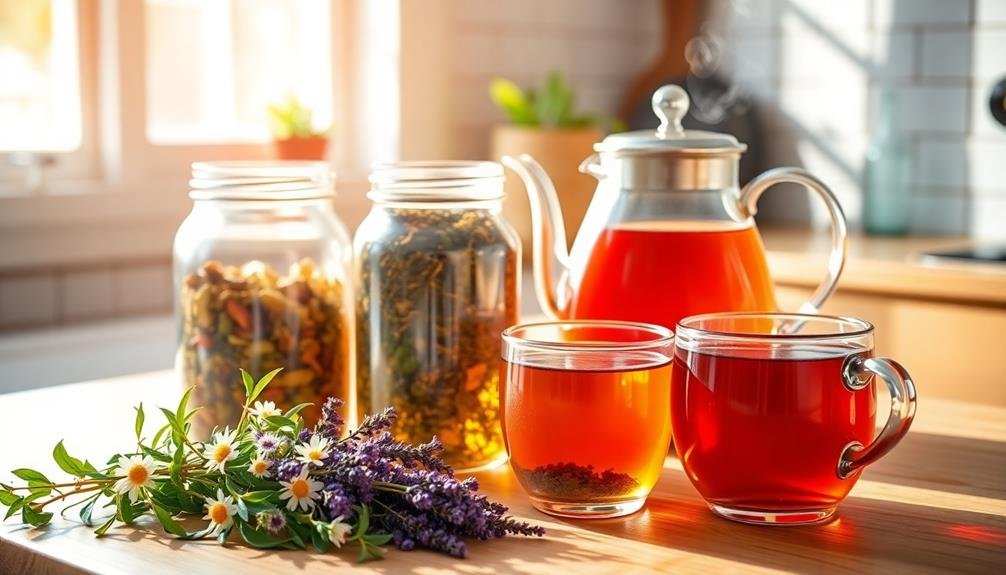
Herbal teas offer a multitude of benefits that can enhance your well-being. When you sip on a warm cup of herbal tea, you're not just treating your taste buds; you're also nourishing your body. These infusions are often packed with antioxidants, which help combat free radicals and can promote overall health. You might find that a daily cup increases your hydration, supporting bodily functions and improving your skin's appearance.
Moreover, herbal teas can aid in digestion. If you're feeling bloated or uncomfortable after meals, certain herbal blends can soothe your stomach and ease discomfort.
You'll also appreciate that many herbal teas are caffeine-free, making them a great choice for evening relaxation or winding down before bed.
In addition, the ritual of brewing and enjoying herbal tea can be a calming experience in itself. Taking a moment to focus on your tea can help reduce stress and promote mindfulness, turning your tea time into a mini self-care session.
Whether you drink it hot or iced, incorporating herbal teas into your daily routine can provide you with physical and mental benefits that contribute to a healthier lifestyle.
Key Ingredients for Calmness
When you're looking to unwind and foster a sense of calm, certain ingredients in herbal tea can work wonders. Start with chamomile, known for its soothing properties. It can help ease tension and promote better sleep, making it an excellent choice for your evening brew.
Another fantastic ingredient is lavender. Its fragrant aroma isn't just pleasant; it's also been shown to reduce anxiety and improve mood. Adding a few dried lavender buds to your tea can transport you to a peaceful garden.
Lemon balm is another key player. This member of the mint family has been used for centuries to alleviate stress and enhance relaxation. Its mild flavor blends beautifully with other herbs, creating a revitalizing cup.
Lastly, consider incorporating passionflower. This lesser-known herb can help calm racing thoughts and improve sleep quality.
Together, these ingredients create a powerful blend that soothes the mind and body.
Popular Anxiety-Reducing Herbs
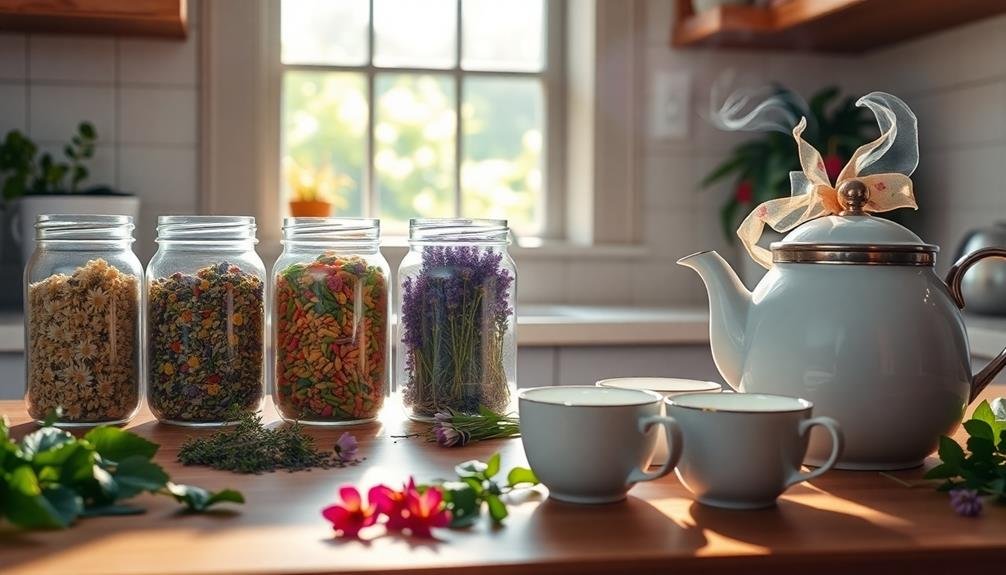
When you're looking to ease anxiety, a few herbs stand out for their calming effects.
Chamomile is known for its soothing properties, while lavender can help you unwind after a long day.
Passionflower is another excellent choice that offers soothing benefits, making them perfect additions to your homemade tea blends.
Chamomile's Calming Properties
Chamomile, renowned for its soothing effects, stands out as one of the most popular herbs for reducing anxiety. When you brew a cup of chamomile tea, you're not just enjoying a warm beverage; you're tapping into centuries of herbal wisdom. This delightful flower is celebrated for its natural calming properties, making it a go-to choice for those seeking relaxation.
The active compounds found in chamomile, such as apigenin, bind to receptors in your brain that help promote sleepiness and reduce anxiety. When you sip chamomile tea, you may feel your worries start to melt away, allowing you to unwind after a long day.
Plus, its gentle flavor and aroma make it an enjoyable addition to your evening routine.
To maximize chamomile's calming effects, consider blending it with other anxiety-reducing herbs like lemon balm or passionflower. This not only enhances the flavor but also boosts the overall soothing experience.
Lavender's Relaxation Effects
For those seeking additional support in managing anxiety, lavender is another powerful herb worth exploring. Known for its calming aroma, lavender can work wonders in creating a sense of tranquility. You might find that sipping on lavender-infused tea not only soothes your mind but also helps ease physical tension.
The primary compounds in lavender, such as linalool and linalyl acetate, interact with your brain's neurotransmitters, promoting relaxation and reducing stress. When you brew a cup of lavender tea, you're not just enjoying a flavorful beverage; you're also inviting a wave of calm into your day.
To craft your own lavender tea blend, consider combining dried lavender buds with other calming herbs like chamomile or lemon balm. Steep the mixture for about 5 to 10 minutes, allowing the flavors and benefits to meld together.
You'll likely notice how the gentle scent and taste can help you unwind after a long day. Incorporating lavender into your daily routine can provide you with a natural remedy for anxiety.
Passionflower's Soothing Benefits
Passionflower offers a gentle yet effective approach to easing anxiety, making it a popular choice in herbal tea blends. This remarkable herb works by increasing levels of gamma-aminobutyric acid (GABA) in your brain, which can help calm racing thoughts and promote relaxation. When you sip on a warm cup of passionflower tea, you might feel your worries begin to melt away, allowing you to embrace tranquility.
To help you visualize the soothing qualities of passionflower, here's a simple breakdown:
| Benefit | Experience | Usage Tips |
|---|---|---|
| Calming Effect | A serene, peaceful mind | Brew for 5-10 minutes |
| Sleep Aid | Restful, deep sleep | Drink before bedtime |
| Mood Stabilizer | Balanced emotional state | Combine with chamomile |
| Stress Reliever | Relief from daily stress | Enjoy as needed |
Incorporating passionflower into your herbal tea blends not only enhances flavor but also promotes a sense of well-being. So, why not give it a try and discover the calming benefits for yourself?
DIY Tea Blending Techniques
Creating your own herbal tea blends at home can be a rewarding experience, allowing you to customize flavors and benefits to suit your taste.
Start by selecting a base herb, like chamomile or peppermint, which will form the foundation of your blend. Next, think about the additional herbs you want to incorporate. Consider what flavors complement each other, such as adding lemon balm for a citrusy note or lavender for a floral touch.
Measure your herbs using a scale or measuring spoons to guarantee consistency. A good rule of thumb is to use one part base herb to one part additional herbs, adjusting to your preference.
Once you've decided on ratios, mix the herbs in a dry, clean bowl. Don't forget to smell the blend as you go; your nose can guide you in balancing flavors.
When you're satisfied, store your blend in an airtight container away from light and moisture. This will help preserve the freshness.
Recipes for Soothing Blends
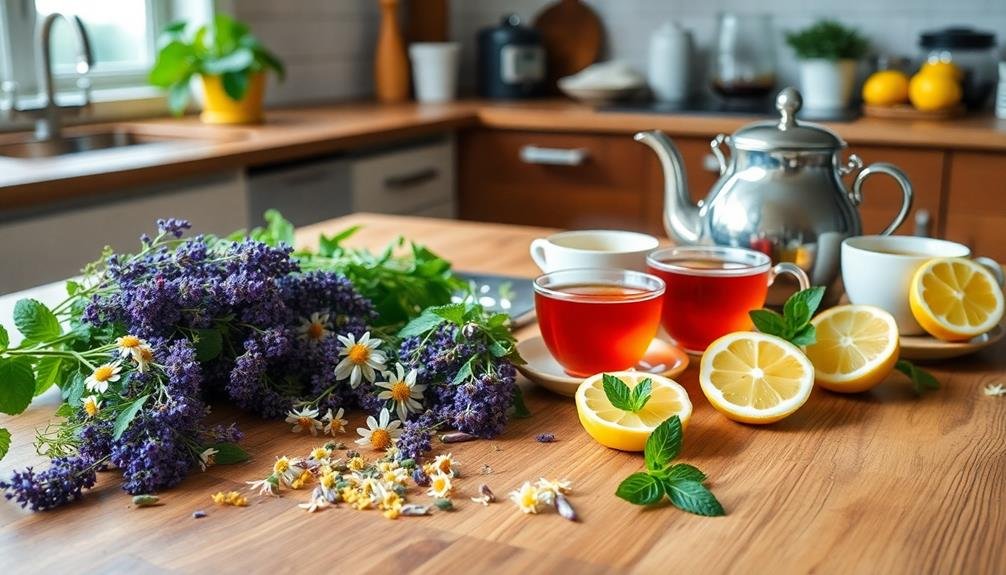
If you're looking to unwind, soothing herbal tea blends can be your best friend.
You can create calming chamomile infusions, relaxing lavender mixtures, and invigorating peppermint blends right at home.
Let's explore these recipes that promise to bring you tranquility and rejuvenation.
Calming Chamomile Infusion
How can a warm cup of chamomile tea transform your evening into a peaceful retreat? This soothing infusion is your perfect companion for winding down after a long day. Chamomile isn't just comforting; it's packed with properties that help reduce anxiety and promote sleep.
Here are a few calming chamomile blends you can easily create at home:
| Ingredient | Amount | Benefits |
|---|---|---|
| Dried chamomile | 1 tablespoon | Eases anxiety |
| Lemon balm | 1 teaspoon | Enhances relaxation |
| Honey (optional) | To taste | Adds sweetness |
| Ginger (fresh) | 1 slice | Provides warmth |
To make your calming infusion, steep the chamomile and any additional ingredients in hot water for about 5-7 minutes. Strain, add honey if you like, and enjoy the aromatic experience. You'll find that this simple ritual helps clear your mind and sets the stage for a restful night. So, brew a cup tonight and let chamomile work its magic, guiding you toward tranquility and peace.
Relaxing Lavender Mixture
Lavender tea is a delightful way to unwind, and it's known for its calming properties that can elevate your evening routine. To craft your own relaxing lavender mixture, gather dried lavender buds, chamomile flowers, and a hint of lemon balm. This combination not only enhances the soothing qualities of lavender but also creates a fragrant and flavorful experience.
Start with one tablespoon of dried lavender buds, one tablespoon of chamomile flowers, and half a tablespoon of lemon balm. Mix these ingredients in a bowl, allowing the scents to blend.
When you're ready to brew, take one teaspoon of the mixture per cup of hot water. Steep it for about five to seven minutes, depending on how strong you like your tea.
Sweeten your brew with honey or agave if desired, and add a slice of lemon for an extra zest. Sip slowly and let the stress of the day melt away.
You can also experiment by adding a few mint leaves for an invigorating twist. This relaxing lavender mixture can become your go-to blend for those cozy evenings when you need a moment of tranquility.
Refreshing Peppermint Blend
After a calming lavender tea, you might crave something a bit more invigorating. The revitalizing peppermint blend is just what you need to perk up your spirits and clear your mind. This blend not only lifts your mood but also aids digestion, making it perfect for any time of day.
To create your revitalizing peppermint tea, start with a handful of fresh peppermint leaves. If you can't find fresh leaves, dried peppermint works just as well. Boil about two cups of water and steep the leaves for 5 to 7 minutes, allowing the vibrant flavors to emerge.
If you want to enhance the taste, consider adding a slice of fresh lemon or a teaspoon of honey. This will add a zesty kick and a touch of sweetness.
Once the tea's ready, strain it into your favorite mug, and take a moment to appreciate the invigorating aroma. Sip slowly and feel the stress melt away as the revitalizing peppermint works its magic.
Enjoy this blend in the morning to kickstart your day or in the afternoon for a revitalizing boost. You'll love how this simple yet effective blend uplifts your mood!
Tips for Brewing Herbal Tea
Brewing the perfect cup of herbal tea can transform your daily routine into a soothing ritual. Start by choosing high-quality loose leaf herbs or tea bags. Freshness matters, so opt for herbs that've been stored properly and aren't past their expiration date.
Use filtered water, as tap water may contain impurities that affect flavor. Heat your water to the right temperature: around 200°F (93°C) is ideal for most herbal blends. If you're using delicate flowers, like chamomile, aim for slightly cooler water.
Measure about one teaspoon of loose herbs per cup; adjust based on your taste preference. Once the water's hot, pour it over the herbs and cover your cup to trap the steam. Allow the tea to steep for 5 to 10 minutes, depending on the herbs' strength and your desired flavor.
Storing Your Tea Blends
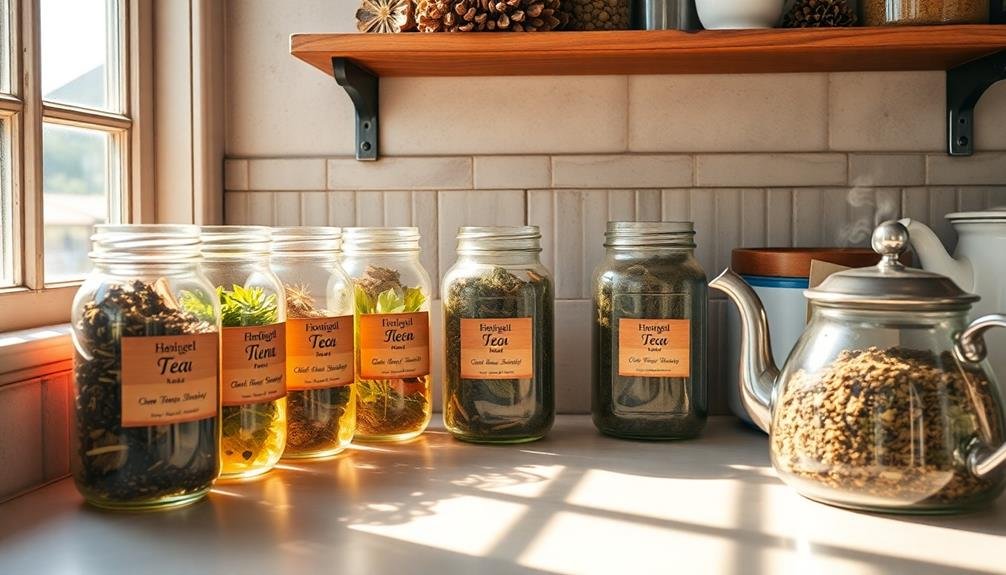
To enjoy your herbal tea blends at their best, proper storage is key. Start by choosing an airtight container; glass jars with tight-fitting lids work wonderfully. Avoid plastic containers, as they can retain odors and may not seal tightly enough.
Next, keep your tea in a cool, dark place. Light, heat, and humidity can degrade the quality of your herbs, causing them to lose flavor and potency over time. A pantry or cupboard away from the stove is ideal.
Label your containers with the blend's name and the date you made it. This way, you can keep track of freshness and enjoy your blends at their peak. Most herbal teas can last up to six months when stored properly, but some may retain their best qualities for even longer.
When you're ready to brew, only take out what you need to minimize exposure to air. Afterward, promptly seal the container again.
Frequently Asked Questions
Can I Use Dried Herbs Instead of Fresh Ones?
Yes, you can use dried herbs instead of fresh ones. Just remember that dried herbs are more concentrated in flavor, so you'll need less than you would with fresh. Adjust the quantity to suit your taste!
How Long Do Tea Blends Last Before Losing Potency?
Tea blends generally last about six months to a year if stored properly. Keep them in a cool, dark place in airtight containers. After that, you'll notice a decline in flavor and potency.
Are There Any Side Effects of Herbal Teas?
Yes, herbal teas can have side effects. You might experience allergies, digestive issues, or interactions with medications. Always check ingredients, consult a healthcare professional, and listen to your body to guarantee safe consumption.
Can I Combine Herbal Teas With Medications?
You can combine herbal teas with medications, but it's essential to consult your healthcare provider first. Some herbs may interact with medications, affecting their efficacy or causing side effects. Always prioritize your health and safety.
Where Can I Buy Quality Herbs for Tea Blending?
You can buy quality herbs for tea blending at local herbal shops, health food stores, or online retailers. Look for organic options and check customer reviews to guarantee you're getting the best quality possible.
In Summary
Crafting your own anxiety-busting herbal tea blends at home can be both enjoyable and rewarding. By choosing the right ingredients and experimenting with different techniques, you can create soothing blends that cater to your personal taste. Remember to brew your tea mindfully and store your blends properly to maintain freshness. Embrace the calming ritual of tea-making, and let each sip work its magic, helping you find a moment of peace in your busy day.

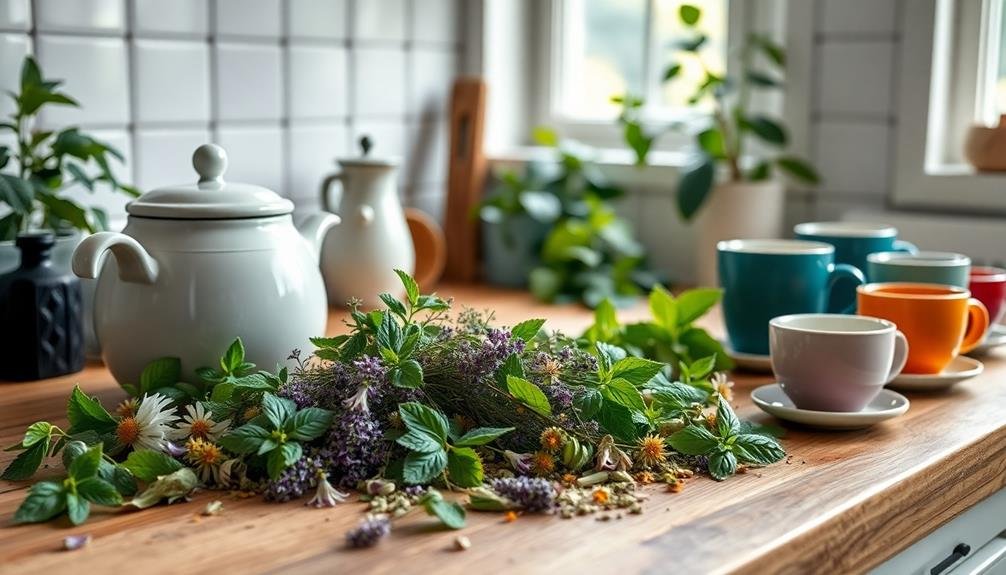
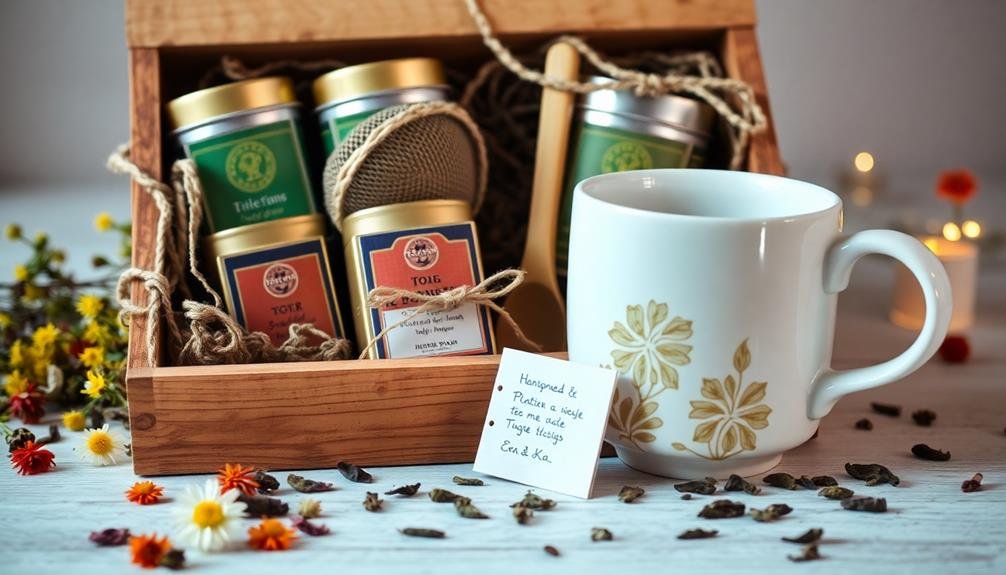
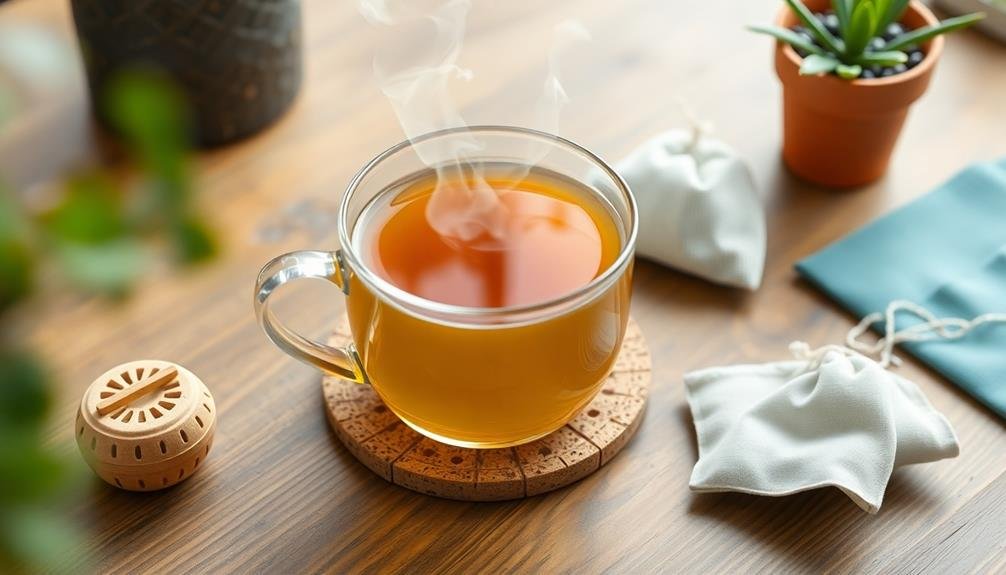
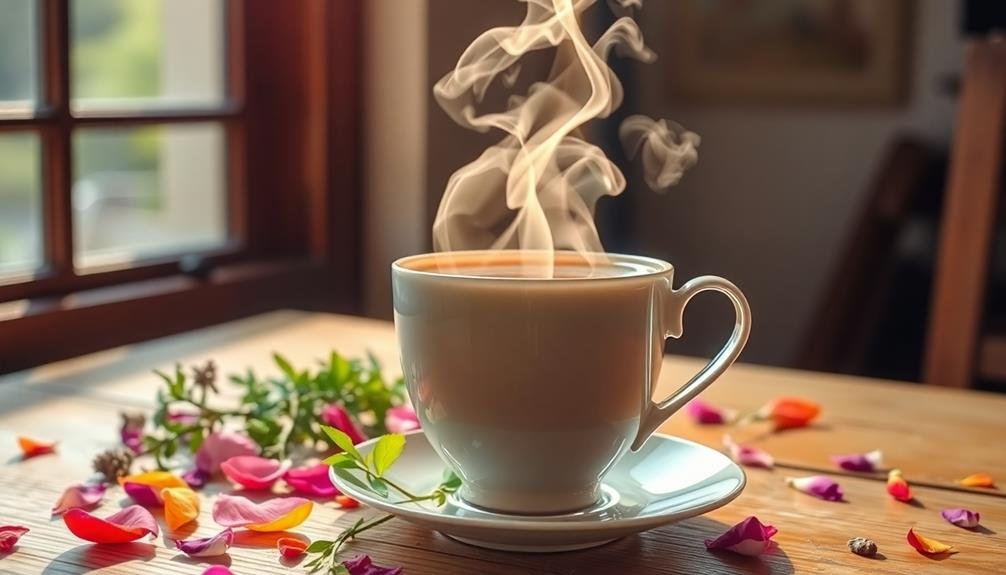
Leave a Reply